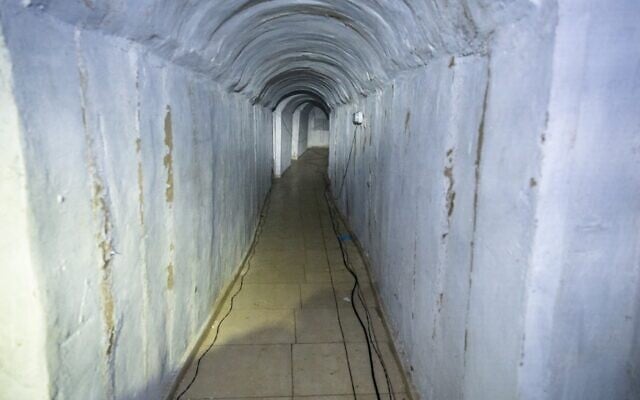‘Systematic torture and terror’: Health Ministry releases report on 12 freed hostages
Report given to Red Cross says 12 hostages who were freed from Hamas captivity in early 2025 suffered psychological humiliation, medical neglect and sexual harassment in Gaza

Blindfolded nighttime marches through tunnels. Worm-infested food. Months without showering or changing clothes.
A report shared Tuesday by the Health Ministry with the Red Cross and international health organizations describes the ordeals faced by 12 of the hostages who were abducted by Hamas-led terrorists on October 7, 2023, and freed during a ceasefire earlier this year.
The Red Cross has not been able to provide any assistance to the hostages during their time in captivity.
Based on testimony and medical records, it details systematic methods of physical and psychological degradation, including ongoing sexual harassment and subhuman conditions.
The abuse laid out in the report, the ministry said, constitutes torture and serious violations of international humanitarian law and called for the immediate provision of food, water and medical treatment to those still in captivity.
The report comes days after terror groups published videos of two hostages looking emaciated, and as Israel endeavors to keep international attention on the plight of the captives, 50 of whom remain held by terror groups in Gaza. It was also published as relatives of the hostages rail against a new government plan to conquer Gaza City, which they say will endanger at least 20 hostages thought to still be alive.
Based on the testimony it laid out, the report said that the living captives are “in immediate danger,” adding, “Every additional day there increases the risk of irreversible damage to their physical and mental health.”
Regarding the freed captives, it said, “There is a direct link between the duration of captivity, the harsh conditions in which the abductees were held, and the continued abuse of the survivors, and the survivors’ ability to undergo rehabilitation processes and reintegrate into family life and society.”
A harrowing picture
The report focuses on four women and eight men who were among the 251 people kidnapped during the Hamas-led October 7 attack, when thousands of terrorists invaded Israel and massacred some 1,200 people. The hostages included in the report were all released during the two-month ceasefire that went from January to March 2025.
The 12 hostages received medical care at four Israeli hospitals: Shamir Medical Center, Sheba Medical Center, Rabin Medical Center and Soroka Medical Center, where they were reunited with their families and provided initial treatment.
The report is based on the testimonies of the freed captives, thorough examinations of medical records and direct conversations with healthcare providers, recounted with the survivors’ informed consent. It accords with testimonies from other hostages.
The report paints a harrowing picture. Captives were held in dire underground conditions, often in narrow tunnels barely two square meters (21 square feet) in size and under 1.5 meters (5 feet) tall, crammed with up to six people for extended periods.
When the hostages were moved, transfers occurred abruptly under threat to life, sometimes involving long nocturnal walks while blindfolded. The ministry determined that such transit was physically dangerous and mentally scarring.
Many hostages were tightly bound for hours without regard for basic physiological needs, it said. They slept on hard tunnel floors amid insects, exposed to constant oppressive heat or freezing cold.
Lack of food and water
The report said that hostages sometimes had no more than one meal daily, consisting of pita or rice, and sometimes none at all. Frequently, the food was spoiled, worm-infested, and accompanied by contaminated water, often untreated sewage or seawater.
Opportunities for good hygiene were minimal: showers were offered once every few months, with cold water and a shared towel. Clothing changes were rare, with some captives forced to wear the same underwear for six months.
Latrines were makeshift holes dug by captives. In some cases, they were forced to relieve themselves in public view.

The harsh environment, the report said, produced persistent, untreated illnesses including recurrent intestinal infections with abdominal pain, vomiting, diarrhea, and high fever. Exposure to dust and sand triggered chronic respiratory ailments.
Captivity also brought infestations of lice, scabies and fleas in the hostages’ skin along with dermatitis and rashes that persisted even after release.
“Because these diseases were not treated, they caused severe hallucinations and intense pain,” the report said. “Several hostages described severe dehydration leading to confusion and even loss of consciousness.”
Physical injuries were extensive. Hostages sustained bullet wounds, shrapnel wounds, burns and untreated fractures. Many hostages have permanent nerve damage resulting in chronic, sharp or burning pain, loss of function, and sensitivity to touch. The hostages reported that even showers can be painful, and they often need to take daily pain medication.
Severe nutritional deficiencies
The hostages suffered severe weight loss, ranging between 15 percent and 40% of body mass, combined with muscle wasting and reduced bone density, placing them at high risk for future fractures and osteoporosis.
Laboratory tests revealed severe nutritional issues such as Vitamin C deficiency, which manifested in gum bleeding and classic scurvy symptoms. Vitamin K and D levels were also low, while Vitamin A was near the bottom of the normal range.
These issues, compounded by starvation and poor hygiene, compromised the hostages’ immunity and increased their vulnerability to infections.
The report said the hostages suffered from dangerous medical neglect, and antibiotic treatment was withheld. The report depicted one hostage who attempted to treat an orthopedic injury on himself, only to lose consciousness during the effort. Another was given the wrong antibiotic, worsening an infection and risking long-term damage or death.

Terror and long-lasting trauma
The hostages also experienced prolonged isolation. One person was confined alone for over 50 days while injured, while others survived in absolute isolation for more than a year. These conditions led to despair, sensory deprivation and in some cases, dissociation, the report said.
Some captors terrorized their captives psychologically, including by holding armed grenades and counting down.
Captives were also sexually harassed. The report said one woman recalled that the abuse continued for months, and men and women faced humiliating body-focused remarks. It did not provide further detail.
Terrorists also afflicted the hostages through psychological manipulations, such as showing them clean food or water only to deny them access. The report asserted that the captors employed “a systematic array of psychological torture and terror, with long-lasting trauma.”
Survivors now live with irreversible nerve damage, impairing basic daily activities. While some are undergoing surgeries, such as removing nerve-compressing fragments or reconstructing scars, chronic pain and functional limitations are expected to remain.

Doctors also raised concerns about endocrine ailments; women reported menstrual and hormonal changes, with professionals citing “reasonable concerns of future fertility impacts.”
Six months after release, the Health Ministry pointed out that the hostages’ mental health prognosis remains uncertain due to the risk of delayed-onset PTSD, noting that their trauma is expected to linger while fellow captives remain in Gaza.
“As long as additional hostages remain in captivity in Gaza, the rehabilitation and social integration process for those who have returned will be harmed,” the report said.
No comments:
Post a Comment